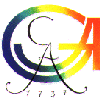Diptera
 Diptera (flies & midges) are among the four hyper-diverse insect orders - the other three being the Lepidoptera (moths & butterflies), Coleoptera (beetles), and Hymenoptera (bees & wasps).
Diptera (flies & midges) are among the four hyper-diverse insect orders - the other three being the Lepidoptera (moths & butterflies), Coleoptera (beetles), and Hymenoptera (bees & wasps).
While human attitudes towards the last-named insect orders are largely sympathetic ('The colourful butterfly is beautiful', 'The beetle, a knight in shining armour', 'The busy bee'), Diptera are not that well-liked.
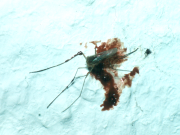 Rather the relationship between man and flies is probably best illustrated by a mosquito smashed on the bedroom wall.
Rather the relationship between man and flies is probably best illustrated by a mosquito smashed on the bedroom wall.
For those, who feel this picture is too drastic, I include an example from the fine arts proving the implied attitude is ubiquitous.
And I would add: it is also common among biologists!
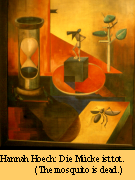 Some dipteran species are indeed a nuisance, some are harmful, some are vectors of dangerous diseases, and some are pest species of cerials and other crops
Some dipteran species are indeed a nuisance, some are harmful, some are vectors of dangerous diseases, and some are pest species of cerials and other crops
but most species are not and many of these play even useful roles as decomposers of plant litter, aphid predators, or pollinators.
Moreover, harmful species also occur in many other insect orders -
so, there is little reason for a general dislike of Diptera.
And Diptera being a highly diverse insect order which is represented by hundreds of species in virtually all terrestrial habitats deserve much more scientific study than they have hitherto attracted.
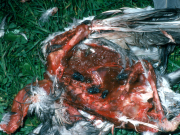 Diptera belong to the holometabolous insects, that is, their life cycles are characterized by complete metamorphosis: In the course of its life time each individual must pass through four developmental stages:
Diptera belong to the holometabolous insects, that is, their life cycles are characterized by complete metamorphosis: In the course of its life time each individual must pass through four developmental stages:
Egg - Larva* - Pupa - Adult
*(the number of larval instars is not constant throughout the Diptera - range: 3 to 20).
I think it is important to be aware of this fact. It is probably impossible to understand how a species can survive in its habitat without considering and studying all life history stages.
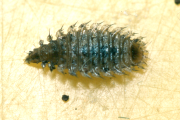 Feeding habits of both larvae and adults are highly diverse in the Diptera, and certainly more diverse than, f.e., in the Lepidoptera.
Feeding habits of both larvae and adults are highly diverse in the Diptera, and certainly more diverse than, f.e., in the Lepidoptera.
In part, this may be due to the many different sorts of mouthparts, which have evolved in both the larvae and adults of Diptera.
Therefore, Diptera as an insect order are not only adapted to feed on a broad range of food resources but also to many different ways of food utilization.
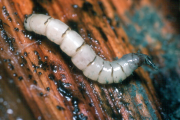 Among the dipteran larvae there are
saprophages, which may feed on dead leaves, dead wood, carrion, etc., and the micro-organisms associated with such substrates;
Among the dipteran larvae there are
saprophages, which may feed on dead leaves, dead wood, carrion, etc., and the micro-organisms associated with such substrates;
phytophages, which may feed on all sorts of living plant parts (usually as miners or gallers);
zoophages, who may prey, for example, on other dipteran larvae, insect larvae, snails, mussels, etc.; a large number of species are parasitoids of arthropod hosts, others parasites of vertebrates.
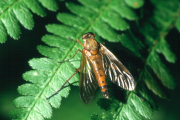 Feeding habits of adult Diptera are also higly diverse: many species are predators as adults (f.e., the robber fly shown above), others are ectoparasites as the mosquito females, and saprophagy, too, occurs in many species. A large number of dipteran adults visits flowers (phytophagy) feeding on nectar and/or pollen. Finally, there are species, which do not take up any food at all as adults. Larval and adult feeding habits can be combined in virtually any way in individual species but adults of species with soil-dwelling predacious larvae are usually predators too or feed on nectar and/or pollen as flower visitors.
Feeding habits of adult Diptera are also higly diverse: many species are predators as adults (f.e., the robber fly shown above), others are ectoparasites as the mosquito females, and saprophagy, too, occurs in many species. A large number of dipteran adults visits flowers (phytophagy) feeding on nectar and/or pollen. Finally, there are species, which do not take up any food at all as adults. Larval and adult feeding habits can be combined in virtually any way in individual species but adults of species with soil-dwelling predacious larvae are usually predators too or feed on nectar and/or pollen as flower visitors.
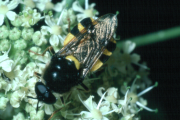 Ecological studies of Diptera have largely concentrated on species of economic importance, a few 'attractive' dipteran families such as the hoverflies, or species easily maintained in lab cultures. This has resulted in a poor representation of many dipteran families in ecological research, which is not justified.
Ecological studies of Diptera have largely concentrated on species of economic importance, a few 'attractive' dipteran families such as the hoverflies, or species easily maintained in lab cultures. This has resulted in a poor representation of many dipteran families in ecological research, which is not justified.
Rather Diptera offer a wide field for creative research in all areas of ecology.
Selected Publications
HÖVEMEYER, K. (2000): Ecology of Diptera. In: PAPP, L.& DARVAS, B. (eds): Manual of Palaearctic Diptera. Science Herald, Budapest; pp: 437-489.
